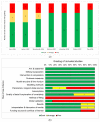The Impact of Rubella Vaccine Introduction on Rubella Infection and Congenital Rubella Syndrome: A Systematic Review of Mathematical Modelling Studies
- PMID: 33503898
- PMCID: PMC7912610
- DOI: 10.3390/vaccines9020084
The Impact of Rubella Vaccine Introduction on Rubella Infection and Congenital Rubella Syndrome: A Systematic Review of Mathematical Modelling Studies
Abstract
Introduction: Rubella vaccines have been used to prevent rubella and congenital rubella syndrome (CRS) in several World Health Organization (WHO) regions. Mathematical modelling studies have simulated introduction of rubella-containing vaccines (RCVs), and their results have been used to inform rubella introduction strategies in several countries. This systematic review aimed to synthesize the evidence from mathematical models regarding the impact of introducing RCVs.
Methods: We registered the review in the international prospective register of systematic reviews (PROSPERO) with registration number CRD42020192638. Systematic review methods for classical epidemiological studies and reporting guidelines were followed as far as possible. A comprehensive search strategy was used to identify published and unpublished studies with no language restrictions. We included deterministic and stochastic models that simulated RCV introduction into the public sector vaccination schedule, with a time horizon of at least five years. Models focused only on estimating epidemiological parameters were excluded. Outcomes of interest were time to rubella and CRS elimination, trends in incidence of rubella and CRS, number of vaccinated individuals per CRS case averted, and cost-effectiveness of vaccine introduction strategies. The methodological quality of included studies was assessed using a modified risk of bias tool, and a qualitative narrative was provided, given that data synthesis was not feasible.
Results: Seven studies were included from a total of 1393 records retrieved. The methodological quality was scored high for six studies and very high for one study. Quantitative data synthesis was not possible, because only one study reported point estimates and uncertainty intervals for the outcomes. All seven included studies presented trends in rubella incidence, six studies reported trends in CRS incidence, two studies reported the number vaccinated individuals per CRS case averted, and two studies reported an economic evaluation measure. Time to CRS elimination and time to rubella elimination were not reported by any of the included studies. Reported trends in CRS incidence showed elimination within five years of RCV introduction with scenarios involving mass vaccination of older children in addition to routine infant vaccination. CRS incidence was higher with RCV introduction than without RCV when public vaccine coverage was lower than 50% or only private sector vaccination was implemented. Although vaccination of children at a given age achieved slower declines in CRS incidence compared to mass campaigns targeting a wide age range, this approach resulted in the lowest number of vaccinated individuals per CRS case averted.
Conclusion and recommendations: We were unable to conduct data synthesis of included studies due to discrepancies in outcome reporting. However, qualitative assessment of results of individual studies suggests that vaccination of infants should be combined with vaccination of older children to achieve rapid elimination of CRS. Better outcomes are obtained when rubella vaccination is introduced into public vaccination schedules at coverage figures of 80%, as recommended by WHO, or higher. Guidelines for reporting of outcomes in mathematical modelling studies and the conduct of systematic reviews of mathematical modelling studies are required.
Keywords: congenital rubella syndrome; data synthesis; rubella; rubella-containing vaccines; systematic review.
Conflict of interest statement
The authors declare no conflict of interest.
Figures


Similar articles
-
Rubella Vaccine Introduction in the South African Public Vaccination Schedule: Mathematical Modelling for Decision Making.Vaccines (Basel). 2020 Jul 13;8(3):383. doi: 10.3390/vaccines8030383. Vaccines (Basel). 2020. PMID: 32668819 Free PMC article.
-
Rubella vaccination in India: identifying broad consequences of vaccine introduction and key knowledge gaps.Epidemiol Infect. 2018 Jan;146(1):65-77. doi: 10.1017/S0950268817002527. Epub 2017 Dec 4. Epidemiol Infect. 2018. PMID: 29198212 Free PMC article.
-
Introduction of rubella-containing-vaccine to Madagascar: implications for roll-out and local elimination.J R Soc Interface. 2016 Apr;13(117):20151101. doi: 10.1098/rsif.2015.1101. J R Soc Interface. 2016. PMID: 27122178 Free PMC article.
-
Congenital rubella syndrome: a matter of concern.Rev Panam Salud Publica. 2015 Mar;37(3):179-86. Rev Panam Salud Publica. 2015. PMID: 25988255 Review.
-
Vaccines for measles, mumps, rubella, and varicella in children.Cochrane Database Syst Rev. 2020 Apr 20;4(4):CD004407. doi: 10.1002/14651858.CD004407.pub4. Cochrane Database Syst Rev. 2020. Update in: Cochrane Database Syst Rev. 2021 Nov 22;11:CD004407. doi: 10.1002/14651858.CD004407.pub5. PMID: 32309885 Free PMC article. Updated.
Cited by
-
Exploring potential applications of measles and rubella microarray patches (MR-MAPs): use case identification.Front Public Health. 2023 Jun 12;11:1165110. doi: 10.3389/fpubh.2023.1165110. eCollection 2023. Front Public Health. 2023. PMID: 37377552 Free PMC article.
-
Epidemiologic and clinical updates on viral infections in Saudi Arabia.Saudi Pharm J. 2024 Jul;32(7):102126. doi: 10.1016/j.jsps.2024.102126. Epub 2024 Jun 8. Saudi Pharm J. 2024. PMID: 38966679 Free PMC article.
-
A retrospective 5-year review of rubella in South Africa prior to the introduction of a rubella-containing vaccine.PLoS One. 2022 May 5;17(5):e0265870. doi: 10.1371/journal.pone.0265870. eCollection 2022. PLoS One. 2022. PMID: 35512030 Free PMC article.
-
Epidemiological characteristic of rubella by age group during 12 years after the national introduction of rubella vaccine in Hangzhou, China.Hum Vaccin Immunother. 2022 Nov 30;18(5):2054208. doi: 10.1080/21645515.2022.2054208. Epub 2022 Mar 28. Hum Vaccin Immunother. 2022. PMID: 35344684 Free PMC article.
-
Low Susceptibility of Rubella Virus in First-Trimester Trophoblast Cell Lines.Viruses. 2022 May 27;14(6):1169. doi: 10.3390/v14061169. Viruses. 2022. PMID: 35746641 Free PMC article.
References
-
- Fone D.L., Hollinghurst S., Temple M., Round A., Lester N., Weightman A.L., Roberts K., Coyle E., Bevan G., Palmer S. Systematic review of the use and value of computer simulation modelling in population health and health care delivery. J. Public Health. 2003;25:325–335. doi: 10.1093/pubmed/fdg075. - DOI - PubMed
LinkOut - more resources
Full Text Sources
Other Literature Sources

